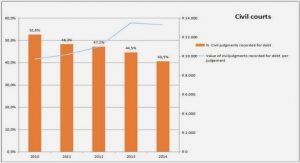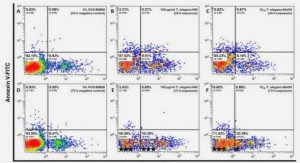Get Complete Project Material File(s) Now! »
The effect of stopping criteria on the correlation between modelled volumes and traffic counts
As shown above, in order to obtain stable assignment results to be used in the financial evaluation of projects it is necessary to use very small values of the relative gap for the stopping criterion. However, many traffic assignments are used to provide traffic volumes that are used to assist engineers in the design of new facilities. The question therefore is what stopping criterion would be suitable to provide reliable information for this purpose.
One way of doing this would be to compare assigned volumes with traffic counts. In 2000 a number of screen line counts were carried out for the calibration of a new model for Gauteng. A total of 79 stations were counted providing 158 directional counts that could be compared with assignments results. Once again assignments were carried out using a wide range of number of iterations and relative gaps as stopping criteria. The results of this investigation are summarized in Table 4.6 (I = number of iterations, RG = relative gap). The results shown in Table 4.6 indicate that the degree of convergence of the equilibrium assignment process has virtually no effect on the correlation between modelled and counted volumes. This would seem to agree with Sheffi’s statement that most of the convergence takes place in the first few iterations. It should, however, be pointed out that many of the screen line counts were done in rural and semi-rural areas where there is little congestion. Different results may have been obtained if more counts in congested city areas had been used.
The fact that the degree of convergence has little or no effect when comparing modelled with counted volumes and yet has a significant effect in the finacial evaluation of projects can be explained as follows. Consider a road operating at or near its capacity of 4000 vehicles per hour. A difference of plus or minus 100 vehicles would have a very small effect on the regression coefficients shown in Table 4.6 with 158 points being considered. However, the same differences would have a much larger effect on the total time travelled since the road would be operating at the steep section of its link performance function as shown in Figure 1.1.
The results shown in Table 4.6 appear to show that, when compared with counts, a relatively small number of iterations are sufficient to provide reliable estimates of traffic volumes. However, it should be remembered that only a small proportion of the total number of links are included in the comparison. The question that then arose was: how close to the final equilibrium volumes are the link volumes when different stopping criteria are used? It was thought that it would be useful to produce a table that would provide modellers with an idea of the level of confidence they could have in their results compared to the final equilibrium solution.
In order to obtain answers that might be generally applicable, it was decided to test more than a single scenario. Two different models were used, the 1985 PWV Study and the 1991 Vectura Study (Gautrans) models. Although both models modelled the same area, they are different models having different volume delay functions and matrices. As a result, their convergence characteristics are quite different. In addition, six different scenarios using each model were investigated. These different scenarios were obtained by using different networks and different matrices to give different congestion levels (e.g. matrices for 1985, 2000 and 2010 were assigned to the 2000 network). The results of this analysis are shown in Table 4.7.
1 INTRODUCTION
1.1 The Traffic Assignment Problem
1.1.1 Representation of the Transportation Network
1.2 Equilibrium in Transportation Networks
1.3 Some Traffic Assignment Techniques
1.3.1 All-or-nothing assignment
1.3.2 Incremental assignment
1.3.3 Capacity restraint assignment
1.3.4 Equilibrium assignment
1.4 The Assignment Problem as a Mathematical Program
1.5 Braess’ Paradox
2 LITERATURE REVIEW
2.1 Game Theory and Equilibria
2.1.1 Nash equilibrium
2.2 Other Braess’ Networks
2.2.1 Murchland
2.2.2 LeBlanc
2.2.3 Fisk
2.2.4 Fisk and Pallottino
2.2.5 Steinberg and Stone
2.3 Other Traffic Paradoxes
2.3.1 Smith
2.3.2 Cohen and Kelly
2.3.3 Sheffi
2.3.4 Downs-Thomson
2.3.5 Arnott, De Palma and Lindsey
2.3.6 Chen and Hsueh
2.3.7 Bean, Kelly and Taylor
2.3.8 Braess’ paradox in computer networks
2.3.9 Chen
2.4 Predicting the Occurrence of Braess’ Paradox
2.4.1 Pas and Principio
2.4.2 Valiant and Roughgarden
2.5 Eliminating Braess’ Paradox
2.5.1 User Optimal vs System Optimal
3 DESCRIPTION OF THE MODELS USED IN ANALYSIS
3.1 1985 PWV Update Model
3.2 The Vectura Study
3.3 Level of Service
4 THE IMPORTANCE OF USING APPROPRIATE STOPPING CRITERIA IN THE EQUILIBRIUM ASSIGNMENT
4.1 The equilibrium assignment problem
4.2 Stopping Criteria for the Equilibrium Assignment Problem
4.3 Investigation into the Effect of Different Stopping Criteria (Bloy [6], [7])
4.3.1 Effect of number of iterations on the financial evaluation of projects
4.3.2 The effect of stopping criteria on the correlation between modelled volumes and traffic counts
4.3.3 Computational effort
4.4 Conclusions and Recommendations
5 NEW INVESTIGATIONS INTO BRAESS’ PARADOX
5.1 How Often Does Braess’ Paradox Occur?
5.2 Range Where Braess’ Paradox Occurs
5.2.1 Some Theoretical Analysis
5.2.2 A Real-World Network
5.3 Eliminating Braess’ Paradox
5.4 Removing Projects With Braess’ Paradox
6 CONCLUSIONS






